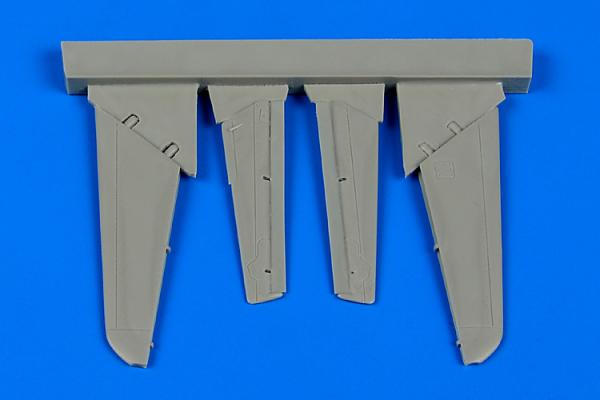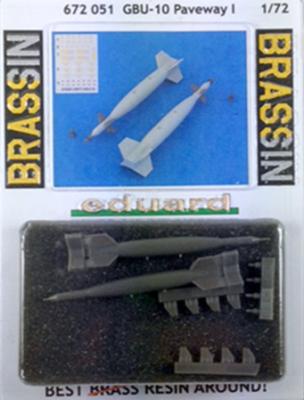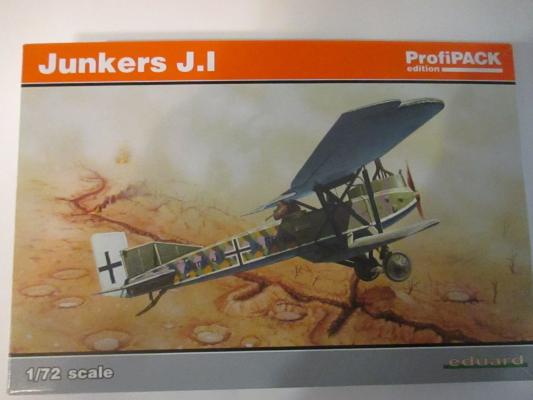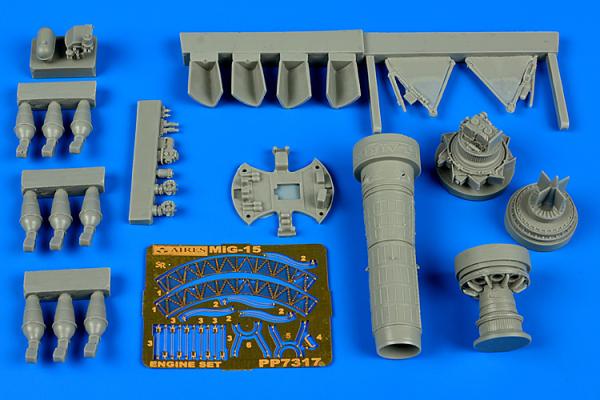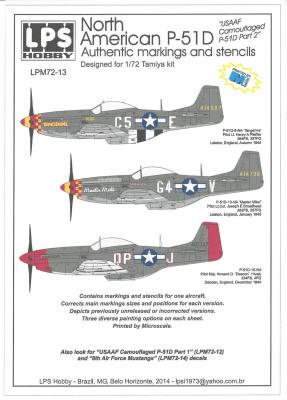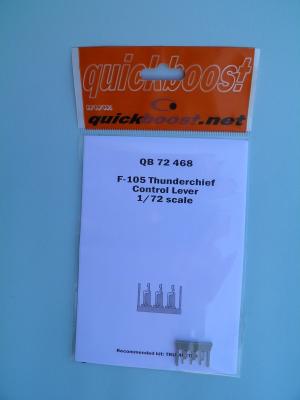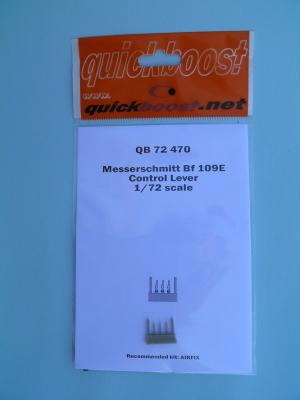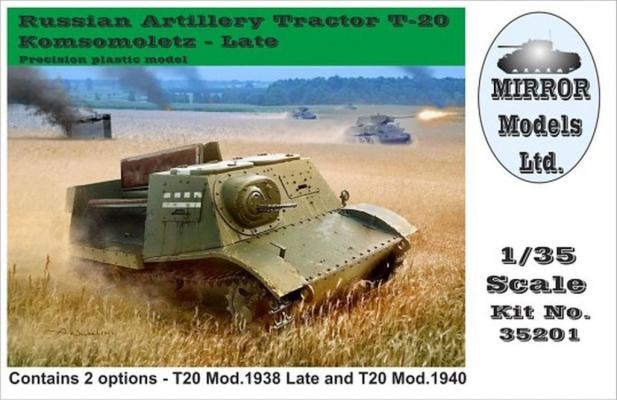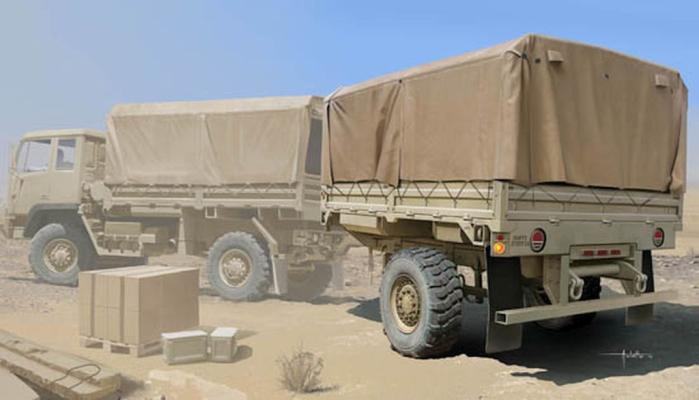The AIRES 1/72 Mig-15 control surfaces aftermarket set gives you elevators and horizontal stabilizers for the Eduard 1/72 Mig-15 kit. The four piece set replaces the two single piece horizontal stabilizers and elevators. The difference is that with the AIRES parts you get separate elevators so you can position them. When I compared the kit parts to the aftermarket parts the resin parts were a bit finer in size and shape and the detail was slightly more refined. The biggest gain of the AIRES set is the positional elevators.
What's New
The GBU-10 Paveway I is one of the United States first precision guided weapons put into service. The GBU-10 is actually the combination of a standard Mk. 84 2,000lb bomb with the Paveway I guidance system. Developed in the late 60’s and early 70’s it was used extensively in Vietnam. While the MK. 84 bomb is still around, the Paveway I guidance package has been replaced by improved versions offering more guidance options and better range.
This is the first kit of what I expect will be a number of F-35 kits from Hasagawa and represents the U.S. Air Force version of the Joint Strike Fighter. The Marine F-35B and Navy F-35C are sure to follow.
History
The Junkers J.1 (Company Model J.4) was one of the most advanced airplanes produced during World War I. When most other plane were of wooden construction with wire braced wings, the J.1 was all metal, with cantilever wings and tailplane, and featured a .20 inch armored shell structure which served as the forward fuselage, protecting the engine, fuel tanks, and crew. The structure was covered mainly by corrugated aluminum, which was to become a Junkers trademark later copied by Henry Ford for his Tri-Motor. Powered by a 200 hp. Benz Bz IV 6 cylinder in-line water cooled engine, the aircraft had an empty weight of 3,885 lbs. and a gross weight of 4,787 lbs. This resulted in a very heavy and underpowered aircraft, but given the role of the aircraft and the state of the art at the time, it was still an impressive airplane. Comparing the type with modern lightplanes, a 65 hp.
The AIRES Mig-15bis engine replacement is a model kit in and of itself. It replaces the 3 part “engine” of the Eduard 1/72 kit. The AIRES kit is made up of 30 resin and 19 photo etch parts. The kit gives you a complete Klimov K-1 engine! The resin is fantastic with great detail and is very easy to remove from the pour plugs. The photo etch is very fine but has strength, so it doesn’t feel flimsy at all.
Build-wise this engine goes together very well and the instructions are pretty easy to follow. The only thing they don’t provide is a list of colors to paint the parts. There are many photos though on the web of Klimov K-1s, so it isn’t too hard to find the color scheme, but it would be nice if they told you what colors each part needed. I used Alclad aluminum, burnt iron, steel and, dark aluminum along with Model Master flat black.
LPS Hobby has been producing many decal sheets of previously unavailable markings, previously incorrect markings and some unusual markings. This particular sheet is no exception. This sheet provides markings for three camouflaged P-51’s which were over-painted with what is believed to be RAF Dark Green and Medium Sea Gray. The decal sheet is printed by Microscale and is in perfect register.
The first aircraft is P-51D-5-NA, “Tangerine”, piloted by LT Henry A. Pfeiffer, 364FS, 357FG, Leiston, England, Autumn 1944. The second is P-51D-10-NA, “Master Mike”, piloted by Lt. Col Joseph E. Broadhead, 362 FS, 357 FG, Leiston, England, January 1945. The last aircraft, and the one I chose is P-51D-15-NA piloted by Major Howard D. “Deacon” Hively, 334 FS, 4FG, Debdon, England, December 1944.
This item from Quickboost is a direct replacement for the control stick for Trumpeter F-105 kits and should be compatible for their D and G models. They should also be useable on the Hasagawa or Monogram/Revell kits. Three new sticks are provided in the package. The detail is a bit finer than the Trumpeter version but they are a bit fragile. As you can see in the pics, I broke off one of the grips just while handling it for the pictures. So use some care when you are removing the sticks from the runner and the flash from the stick itself.
No instructions are provided as they are a direct replacement for the kit part.
So, just be a little careful and you will have a nicely detailed stick for the pit.
Thanks to Aires and IPMS/USA for the review kit.
This new item from Quickboost is a direct replacement for the control stick for Bf 109E models. They recommend it as a replacement for the new Airfix kits but I am sure it would work in any 72nd scale Emil. One nice aspect is they give you 3 new sticks and as I have two of the Airfix kits and a Tamiya one, I am sure all 3 will get used. The detail is a bit finer than the Airfix version and it includes the boot at the bottom of the stick.
No instructions are provided as all you need to do is cut them off the runner and use as a direct replacement for the kit part.
Another simple and quick update for your modeling pleasure.
Thanks to Aires and IPMS/USA for the review kit.
Mirror Models has released a full plastic kit of the Artillery Tractor T-20, which saw service with the Finnish, German and Russian and Romanian Armies (Decals provided for the first 3 armies).
This kit has over 450 plastic parts and it includes some small PE details. The tracks are of the “individual link” style. I don’t think they will “click” to each other; rather glue should be used in each link.
The kit includes a complete engine, engine bay, firewall and transmission. There is no “hull”, it is built from individual pieces, and so careful alignment there will be needed. Once the engine and engine bay plus basic hull is completed, assembly moves into the interior, with nicely detailed seats for the artillery gun crew.
Trumpeter has released the M1082 trailer, which is a welcome addition to military vehicles and dioramas alike.
The kit includes over 180 parts on 5 sprues (1 clear), plus a small PE fret and a plastic string, likely to make tie downs for a tarp -which is not provided-. Decals are provided for two finishes: tri-color “european/Nato” and a sand/desert one.
Construction follows the typical breakdown of most vehicles, that is, it starts with the frame. Careful alignment of the parts at this stage will pay off latter. Construction them moves to the trailer bed itself and finally to the wheels (with tires provided in rubber). It also includes a trailer jack foot, which would allow the trailer to be shown on its own.

